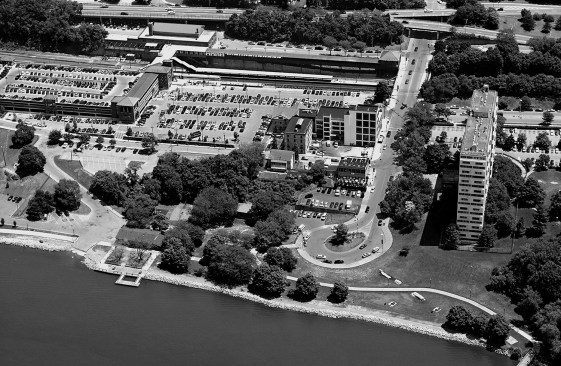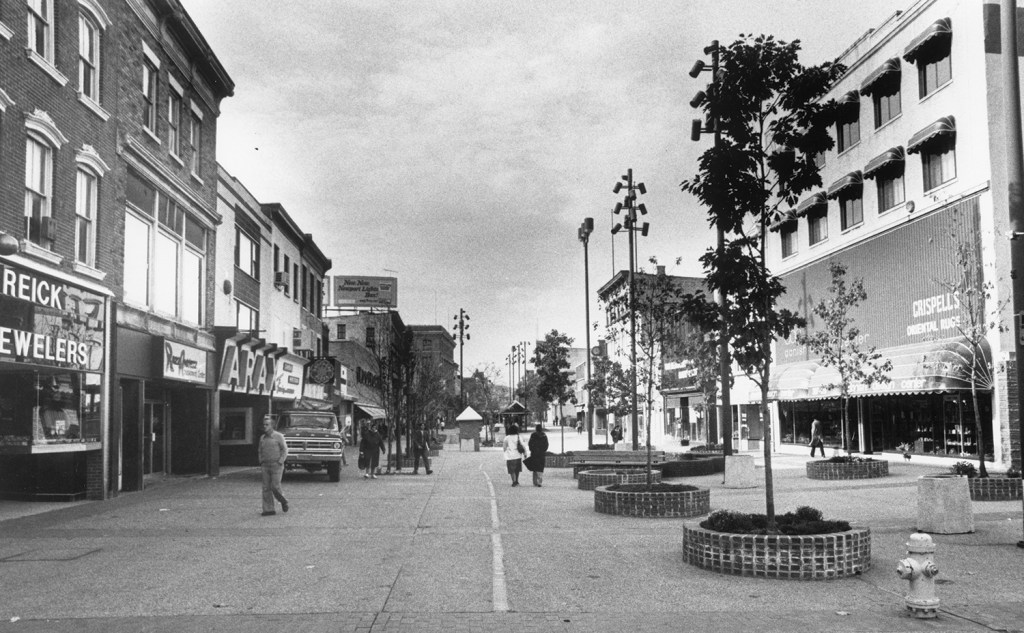In the late 1950s, progress was coming for Poughkeepsie.
The small city of roughly 30,000, 80 miles north of New York City, spills eastward from the Hudson River, its streets forming a network of tributaries that trickle out like an outstretched hand. Its cityscape typifies the architectural eclecticism of ascendant America: a Main Street of mid-rise, densely packed Italianate and castiron façades; neighborhoods of palatial Queen Anne and Second Empire mansions, and others full of more humble Federal and Victorian homes; and heavy red-brick factory buildings scattered about.
This historic landscape was challenged in the immediate postwar period. IBM set up shop on a 450-acre campus just south of the city, and the company was expanding its footprint to accommodate its growing workforce. Surrounding municipalities—and Dutchess County, of which the City of Poughkeepsie is the seat—were aggressive in reshaping zoning to feed the hunger for suburban-style housing and high-speed access roads. In 1958, Poughkeepsie retained the planning firm Candeub, Fleissig & Associates, a leading consultancy of the time, to envision a comprehensive plan that would remedy the city’s supposed blight and traffic, and graft a new, more modern skin onto its traditional urban form.
“Poughkeepsie received more urban renewal funds per person than any other city,” says Harvey Flad, emeritus professor of geography at Vassar College, which sits just outside the city’s border. “[The city] was able to do a lot with that money, especially tearing down; but what they didn’t do, of course, was rebuild a whole lot.”
In the age of automobiles and horizontal expansion, Poughkeepsie declared war on traffic. Route 9, the main north–south thoroughfare at the city’s western edge, was converted into a freestanding highway, cutting the city off from the riverfront while demolishing some 400 homes. The construction of the East–West Arterial, essentially a forked intra-city highway that pinches the downtown in between two one-directional routes, necessitated massive demolitions on the north and south sides of the city.
This was coupled with the creation of Main Mall, an at-the-time progressive idea to pedestrianize Main Street to stave off the threat of Victor Gruen–esque malls on the suburban fringe. Main Mall closed off the city’s main artery to all traffic.
“These arterials completely surround Main Street,” says Flad, co-author of Main Street to Mainframes: Landscape and Social Change in Poughkeepsie (SUNY Press, 2010). “What you have is vehicles going through the city and not to Main. And between Main Street and the arterials, almost all the buildings were torn down for parking lots.”
Poughkeepsie’s core became encased like a jewel wrapped in ribbons of concrete.
Architect Michael Murphy, co-founder of the Boston-based nonprofit architecture firm MASS Design Group, grew up against this backdrop. Known for their “healing” work—such as the proposal for the Kigali Genocide Memorial in Rwanda—MASS’s mission is built on being attuned to the social power embedded in architecture and infrastructure, and to inculcating a publicly informed stance on any design. For Murphy, also an adjunct assistant professor at the Columbia University Graduate School of Architecture, Planning and Preservation (GSAPP), urban renewal’s most lasting legacy on his hometown has been to sever its historic memory and cast a pall over its perception of place.
“It’s striking how severe these projects were,” Murphy says. “The shadows these projects cast on the city were both extreme and banal. By that I mean it’s so car-centric that people drive through the city and don’t notice the historic fabric that once existed; there’s a perception that these arterials have always been there. The memory of this infrastructure has been removed, which has kept it from being a mobilizing force.”
Last summer, MASS opened the Hudson Valley Design Lab (HVDL), an annex in downtown Poughkeepsie that houses both an office and public storefront.

Courtesy of Poughkeepsie Journal. Photographer: Spencer Ainsley
Waterfront aerial. Poughkeepsie’s urban renewal projects encased the city’s core like a jewel in ribbons of concrete.
“We’re here as a catalyst, connector, a partner,” Murphy says. MASS’s goal is to provide a design framework for the city to reclaim the perception of Poughkeepsie’s intact assets—such as direct transportation on the Metro-North railroad to New York City—and anchor institutions—of which there are many either within or immediately outside of the city, including Vassar and Marist colleges, Dutchess Community College, and the Culinary Institute of America. Through the HVDL, MASS is aiming to reframe the pervasive narrative of Poughkeepsie as a place “where the future never came.” Chris Kroner, HVDL senior project manager, describes the HVDL storefront almost as an extension of the street, a place of community engagement and exchange, “to welcome people in and program it more completely.”
In addition to the public gallery, MASS’s HVDL is looking at three specific projects within the city: reimagining the defunct cisterns in College Hill Park; redesigning the hazardous Creek Road roundabout intersection; and increasing access along the Fall Kill creek.
A resulting feature of Poughkeepsie’s urban renewal—on top of the vehicular traffic that bypassed downtown and the Main Mall’s eventual failure (it was decommissioned in 2001)—was to outline in asphalt the city’s economic and racial divisions. From 1970 to the present day, neighborhoods north of the East–West Arterial have been heavily African- American, some more than 60 percent, while certain neighborhoods to the south have been less than 10 percent. (Since the late 1990s, the city has seen a healthy influx of immigrants from Oaxaca, Mexico, into its core.) As of 2015, the city had a poverty rate of 24 percent, nearly 1.5 times the average in New York State.
Urban renewal itself didn’t cause (nor was it designed to exacerbate) poverty, but it did erect concrete barriers toward mitigating poverty’s effects. This worked by concentrating poverty, thereby cutting off neighborhoods from capital, but also by devaluing neighborhood assets, making them susceptible to overdevelopment as market conditions change. This dynamic amplifies the vulnerability of poor neighborhood residents to development if and when it comes—a symptom of a city operating without a functioning market.
“Poughkeepsie is a perfect example of a place abandoned by the marketplace,” Murphy says. He and Kroner envision MASS providing design advocacy to help stem this struggle. “There is the emergence of new organizational typologies that are both public and private, of which MASS is one, and a benefit of that is that there’s public accountability as part of [our] charter,” Murphy says. “That means an ability to both navigate and circumvent market forces, with grant dollars and predevelopment dollars that are necessary to catalyze or seed a market, but also resist a market that’s out of control.”
MASS’s presence is but one domino of mobilization as a larger awareness of urban renewal’s historically negative effects takes hold. Paul Hesse, community development coordinator for the Dutchess County Department of Planning and Development, works exclusively on issues relating to the city. He speaks encouragingly about the conversations taking place between the city, county, and a multitude of motivated organizations while acknowledging the pace to implement real change is incremental.
“The conversation happening just around the arterials has been around for a long time,” he says, referencing a transportation study done in 1997. In 2014, the city adopted the Poughkeepsie City Center Revitalization Plan, proposed by Kevin Dwarka of the Pace University Land Use Law Center. In 2016, the city worked with Sam Schwartz Engineering and the Street Plans Collaborative to test out a complete street concept on Market Street. Now Columbia University GSAPP’s Hudson Valley Initiative, MASS’s HVDL (whose last exhibit showcased GSAPP students’ work), the local nonprofit Hudson River Housing’s Middle Main Initiative, and others all have projects percolating.
“It creates a better environment with all of these institutional partners,” says Hesse, who notes that the City Planning Board has asked MASS to serve as an architectural and planning review organization for proposed projects. “It’s a way to say, ‘architecture matters,’ and bring their community ethos into the review.”
Sarah Salem, a Poughkeepsie native and a first-term city councilmember who’s an advocate for communication between community organizations, “especially before we start designing things,” sees the HVDL as a “great resource filling in gaps where other organizations or nonprofits don’t have capacity.”
“There’s a lot of energy right now to revitalize the city,” Salem says. “More people, more organizations are rowing in the same direction. We’ve got a real chance at doing redevelopment right.”
